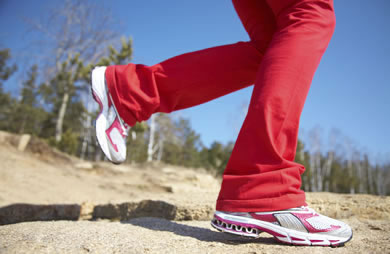|
As a runner it's nice to have a partner to run with, regardless if that partner runs on two legs or four legs. A dog can make a great running partner, not only can they help keep us motivated to run, but they can also provide us with a sense of security and companionship especially for those of us who must run in remote areas. But before you get too eager to put a leash on your four-legged friend, there are a few tips to consider prior to taking your first step out the door with your running buddy. 1. Get medical clearance from your dog's vet Just like we need to get medical clearance for exercise, same is true for our pets. This is especially necessary if your pet has led a fairly sedentary lifestyle. While your dog may spend hours running around the backyard, it is not quite the same as running five, three or even one mile. 2. Know which breeds are best for running Knowing which breeds are best suited for running can help determine if Fido is going to make a great running partner or best left hanging out in the backyard. There are certain breeds where running may actually be detrimental to your dog's well-being. Some breeds, such as the Border Collie are more prone to hip dysplasia issues which can be aggravated from running while other breeds, such as the Pug and Bulldog are more prone to respiratory and overheating issues. Runner's World has compiled a list of dog breeds and the distance each breed can safely run. But remember your dog's vet is the best source of advice as to whether your best friend can run or not. 3. Consider the age of your dog Having a puppy full of energy may seem like the ideal time to train her to run with you, but remember your puppy is still growing. Her bones are still developing. This does not mean she can't ever run with you, but please check with your vet as to the distance and intensity of runs that would be most suitable for your growing puppy. Older dogs can run, depending on the breed and disposition of your dog, just make sure that you have discussed your concerns with your vet before taking Fluffy out for her first run. 4. Make sure your dog is on a leash In my six years as a runner one of the most intimidating experiences is to come across a dog that is not leashed. While you as his owner may be quite comfortable with voice command in controlling your dog, I, as a runner, have no clue how well controlled your dog is. A few years ago I had a Jack Russell Terrier come running at me nipping at my lower leg, thankfully the dog's owner could grab him before any damage was done. My most recent scare came just a few days ago when a German Shepherd who was trained to attack came barreling at me (the owner's description, not mine)--to hear the fear in the owner's voice literally had me stop dead in my tracks until the owner gained control over his dog. 5. Consider the running surface We are fortunate to be able to put on a pair of running shoes and head out the door. We don't have to worry too much about the road temperature or debris, but for your dog this is a big factor. Concrete and debris on the road are big hazards for your dog, especially in the heat of summer when the running surface is very hot. If your dog starts to limp, you will want to stop immediately to check his paws for any foreign body that may have embedded in your dog's paw. Also, if you are running in winter where snow and ice are commonplace, after your run be sure to wash your pet's paws as salt and other chemicals used on the roads can be very toxic to dogs, especially if they are prone to licking. 6. Be aware of the signs and symptoms of overheating Dogs do not sweat like we do. They dissipate the heat via panting and through their paws so make sure you bring plenty of water for him or at least have access to water. My local running trail actually offers pet water stations which allows owner and pet to rehydrate at the same time. Also you may want to change your running surface from a hot road to a cooler trail when temps heat up. If you find you dog is excessively panting, slowing down and not acting like he normally does, you need to cool him off as soon as possible. Just like heat stroke can be fatal to humans, hyperthermia can be fatal to your beloved pet. Many dog experts state that if the ambient air temperature is 80 degrees or warmer, or if there is excessive humidity, it is best to leave your dog at home. The risk at this point for heat stroke far exceeds the benefit for exercise. Here is a link to helping keep your pet cool during the hot summer months. 7. Ease your dog into running Just like many of us did not go from the couch to running 3 miles straight, same is true for your trusty companion. Running is very taxing on the human body and same is true for your dog. While it may seem natural for your dog to want to run with you, after all they love to please us, you must be aware that it takes time to build up the stamina to run the distances you are accustomed to running. So you may want to start with some walks to allow time for your dog to adapt to the routine of going out with you. 8. Know your dog's temperament If your dog has been exposed to other people and other dogs, most dogs will do fine in a running environment. However if your dog has not been socialized, you may want to rethink where and when you will run with him. Remember not everyone is eager to come across a dog even on a leash especially if the breed has a history of being intimidating. While you may know that your German Shepherd or Pit Bull is a sweetheart, I as a runner have no clue. Having a dog who is quite territorial with his environment and even you as an owner, may be more frustrating to you as a runner as you may find yourself keeping your dog in line versus running. If your dog has never been socialized, you may want to consider taking her to obedient classes which many local pet stores and shelters offer for a nominal fee. If you are unable to locate a class, check with your vet, he/she may be able to help you locate a class. 9. Make sure your pet is up-to-date on his vaccination A few weeks ago a friend of mine was running when a stray dog came out of nowhere and bit her on the leg. While this dog was not running with his owner, because the dog was not wearing a collar nor were his vaccinations current, she had to endure a long 10 day wait to see if the dog showed signs of rabies. Should you be running with your dog and he finds himself in an altercation with another dog or another runner, having verification of his vaccinations can bring peace of mind to all parties involved. 10. Be courteous and clean up after your pet Having participated in races where dogs were permitted, nothing is more aggravating to me as a runner than to be running along and stepping in a mess that I have to clean off my running shoes before getting into my car to go home. While it may seem like an inconvenience to carry a bag or two with you to pick up your pet's mess, it really is the courteous thing to do. Also know that many municipalities are now fining dog owners for not picking up after their pet. Taking a few seconds to keep our environment clean makes running enjoyable for everyone. These are just a few tips that may help determine if your pet is ready to hit the running trail with you. However, I want to stress that you need to get clearance from your dog's vet to see if he/she is healthy enough to run. Studies are showing that pet obesity is on the rise, so just like we need time to ease into exercise, we do not want to rush the process in taking Buddy from the couch to running without the proper guidance and time frame to do so. Do you run/walk with your dog? What are some measures you take to keep him/her safe? |
Related Entries
More From SparkPeople
|





.jpg)
.png)
















